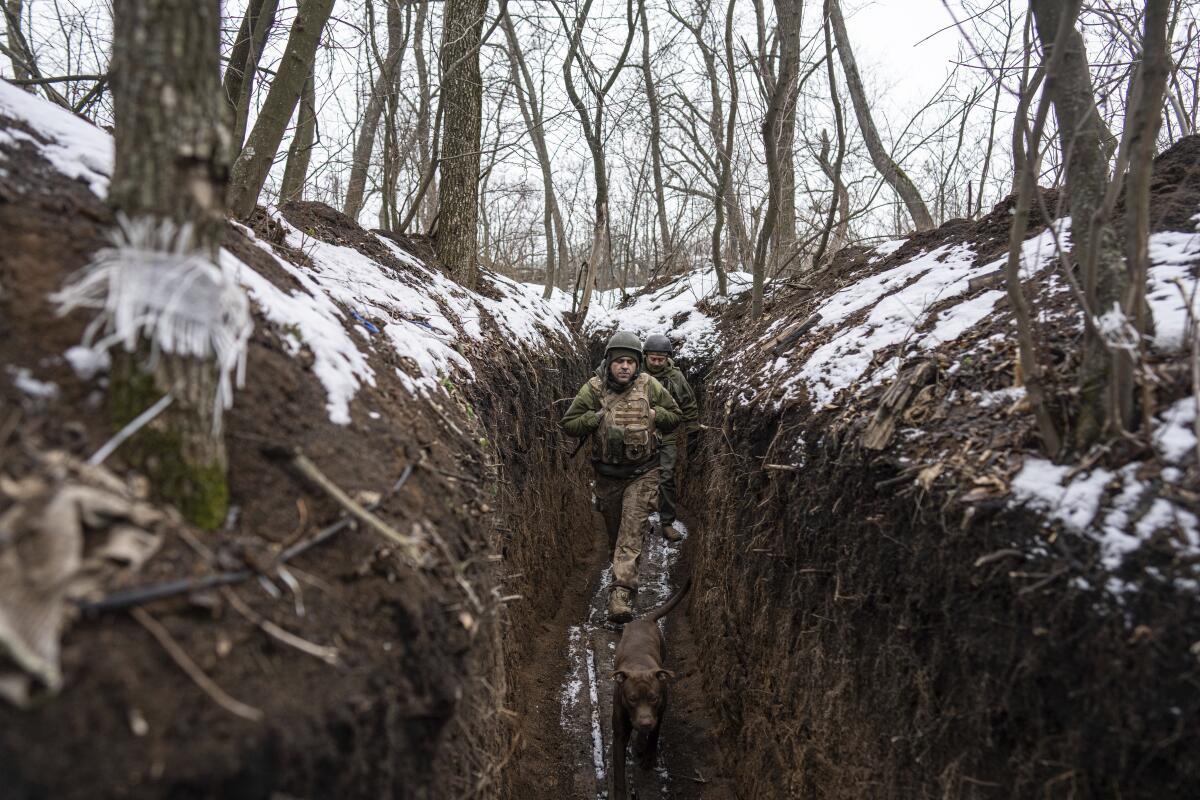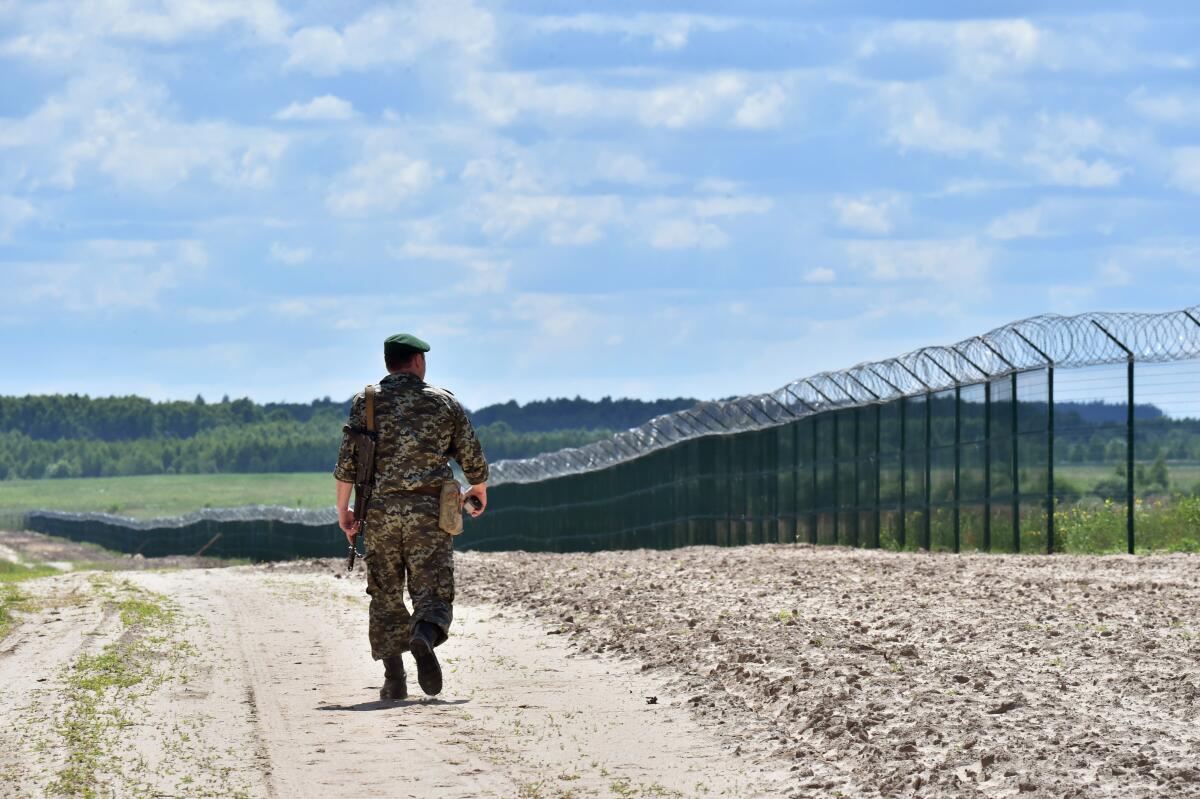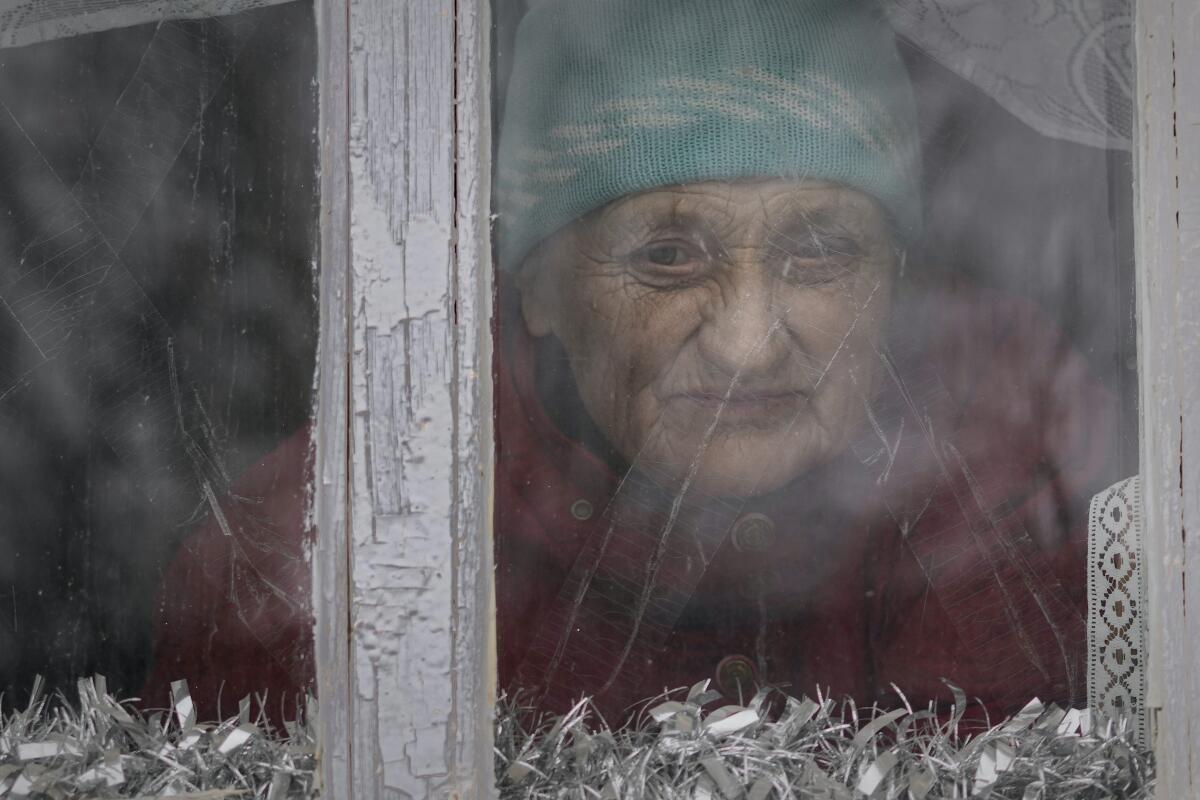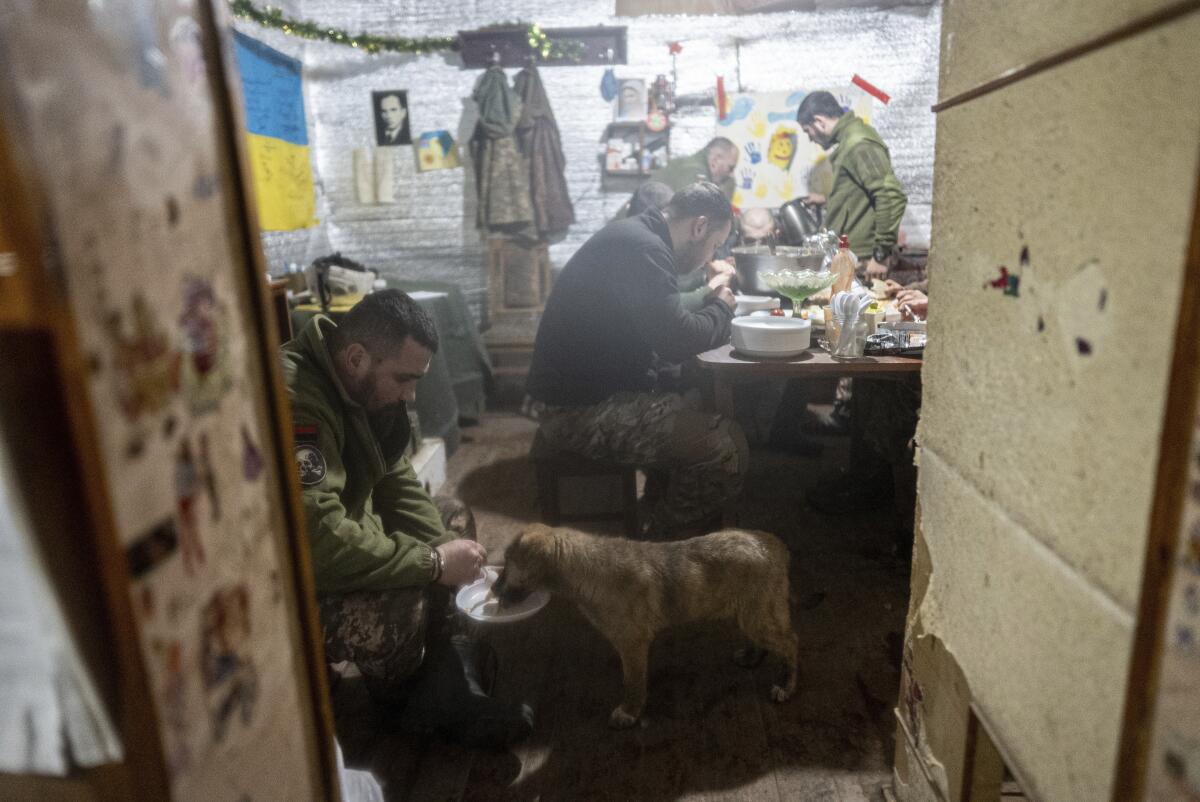A post-Soviet border town in northern Ukraine wonders if Russia is coming back

KLYUSY, Ukraine — It’s hard to find a more tranquil place than this hamlet on the edge of northern Ukraine. A collection of huts sprinkled along a barely there road, it abuts the Zheveda and Tsata rivers. In winter, when the Tsata freezes, the town’s 70 or so residents, many of them old with long memories, punch holes in the riverbed and fish amid a hushed birch forest draped in snow.
“Oh, I just started two weeks ago. I’m a beginner, but I have no luck. The fish aren’t coming,” said Vladimir, a grizzled, affable man in his late 50s who preferred not to give his last name. He adjusted his ushanka, or ear-flap hat, squatted down and gingerly dipped his line for another attempt.
Vladimir has lived in Klyusy all his life. Like other villagers near the border linking Ukraine, Belarus and Russia, he remembered the Soviet Union days when the boundary was little more than a line on paper. Every June, residents would stream through the Senkivka border crossing, six miles west of Klyusy, and join tens of thousands of Ukrainians, Russians and Belarusians celebrating the Slavic Unity Festival held near the Monument of Friendship called the Three Sisters.
But these days there’s more menace than friendship along the border.
“The Russian army is 20 miles from here,” Vladimir said, pointing upstream across the border.
The buildup, comprising tens of thousands of troops, tanks, artillery, advanced S-400 antiaircraft missile systems as well as SU-30 warplanes, is ostensibly for “Allied Resolve 2022” — 10 days of joint military exercises with Belarus that began Thursday. But despite repeated Russian assertions to the contrary, U.S. and NATO officials believe it’s something altogether more sinister: one more turn of the vise on Ukraine.
What appears to be an invasion force has all but encircled a country that Russian President Vladimir Putin, who has described the breakup of the Soviet Union as a 20th century catastrophe, wants back in Moscow’s orbit. In the last few months, he has marshaled more than 100,000 troops on Ukraine’s eastern and northern frontiers and run exercises near the west in Transnistria, a pro-Russia breakaway region sandwiched between Moldova and Ukraine. They’re complemented by Russian naval drills in the Black Sea and the adjoining Sea of Azov. The exercises near Belarus, which NATO Secretary-General Jens Stoltenberg said earlier this month were the biggest Russian deployment there since the Cold War, add 30,000 more troops to the fray.
The videos hint at a formidable force poised to blitz into Ukraine even as Western leaders engage in furious diplomatic maneuvering with their Russian counterparts. On Saturday, Putin had phone calls with President Biden as well as French President Emmanuel Macron; the latter lasted an hour and 40 minutes.
In recent days, analysts and observers have kept close watch on social media accounts, poring over Facebook and TikTok videos depicting Russian armored vehicles, air-defense platforms bristling with missiles and trucks lumbering past the towns and villages of Belarus on their way to its southern frontier.
Konrad Muzyka, an analyst with Rochan Consulting, a Polish-based open-analysis firm, said troops were assembling in staging areas anywhere from 12 to 24 miles from the border.

“What they’re doing is positioning their forces in a way that suggests they’re preparing for war,” he said.
The military logic of having those forces on Ukraine’s northern flank is hard to ignore. If the Russians — as Biden administration officials warned lawmakers over the weekend — plan an attack aimed at Kyiv, Senkivka is a 140-mile, 3½-hour drive on pristine roads; it’s even closer from Novi Yarylovychi, the main crossing point between Ukraine and Belarus, which runs on the E-95, a vital highway.
And those forces’ arrival comes at a time of rising antagonism between Belarus and Ukraine. Belarusian President Alexander Lukashenko once acted as a mediator between Kyiv and Moscow after Russia-backed separatists sparked a war in eastern Ukraine. He has since become Putin’s most vociferous ally. He rarely misses the chance to support the Kremlin and often raises the possibility of allowing a permanent Russian presence along the 674-mile Ukraine-Belarus border.

“No one has ever said that the Russian troops will stay on the territory of Belarus and there has never been any talk about that,” Kremlin spokesman Dmitry Peskov said this week, according to Russian state-news operator Tass. “These are allied military exercises and, naturally, this implies that the troops will return to their permanent bases after these drills are over.”
Still, in an interview last week, Lukashenko said his forces would act in lockstep with the Russian army: “You think we’re joking on our southern border?” he asked in a TV interview Sunday.
The Ukrainians certainly don’t. Ukrainian Defense Minister Oleksii Reznikov said in an interview broadcast Monday that his army will conduct drills in various parts of the country from Feb. 10 to Feb. 20 — the same period of time as the Russian exercises in Belarus — on the use of Turkish Bayraktar drones as well as antitank Javelin and NLAW missiles.
But the sheer length of the border with Belarus, not to mention the more pressing need for troops in the east, discounts the possibility of a more robust defense line, Ukrainian officials say. Instead, they’re relying on border patrol guards, police and emergency personnel backed up by rapidly deployed special forces and hundreds of intelligence officers.
Despite the U.S. and its Western allies ramping up warnings that an invasion could come at any time, so far there was little evidence of any Ukrainian defensive forces near Klyusy and Senkivka other than small groups of soldiers patrolling along a chain-link fence topped with barbed wire. Also missing from the area is a so-called Territorial Defense Force, corps of citizen-soldiers that have been formed in major cities as a foundation for a popular insurgency if Russia invades.
In the meantime, there seemed to be little effect on the movement of shipping, with dozens of trucks lined up for miles on the Ukrainian side waiting to cross the border. One truck driver on his way to Estonia, who gave his name only as Nikolai, said transit between the three neighbors was running as normal, from what he saw.
“I’ve been two hours already,” he said. “It’s my first time here so I don’t know for how long I’m going to have to wait, but on other borders it takes longer.
“I don’t believe there will be war,” he said, adding that the only time he heard about Russian tanks across in Belarus was when “Ukrainian drivers ask us if we’ve seen any.”

Locals too appeared sanguine in the face of a potential invasion. Some — especially older residents — even welcomed the prospect of returning to a time when Moscow played more of a role in their lives — little wonder in a region where people often have stronger familial and economic ties to the neighboring Gomel region in Belarus or Russia’s Bryansk region than to their own capital. (Many speak a unique dialect, a patois of Ukrainian, Russian and Belarusian that sounds alien to those from other parts of the country.)
“We were 15 republics in the Soviet Union, with one president. Now you have 15 presidents and it’s terrible,” said Mikhail Vasilovich, the 57-year-old owner of one of two stores in Senkivka. “How many states are there in the United States? Fifty-two? So imagine if it broke up and you have 52 presidents. What would happen then? Disaster.”
He began to shout, his words slurring with the effect of both alcohol and rage as he instructed a reporter to leave the store.
“Belarus and Russia don’t want to fight us,” he said. “We’re brothers.”
His anger channeled the devastation left behind by the Soviet Union’s demise, which had rendered villages here bereft. Many had fallen into a slowly degrading limbo: The kolkhoz, or collective farm, that once stood in the heart of Senkivka was abandoned, graffiti on its walls warning that the building was liable to collapse. With no jobs, many of the young had left. The quaint, colored cottages with lace-like filigree on their windows were largely abandoned. Much of the area seemed a snapshot of an earlier time: You still needed to use a pulley to fill a bucket from the well; shopkeepers calculated bills with an abacus.
Not all, however, had such a rose-tinted view of the Soviet past.
“I’m not sad the Soviet Union was gone. Yes, there was no official border, but Russia’s attitude was always that Ukraine was its little sister,” said Vladimir, the ice fisherman. If the Russians come, common roots or not, he said, some in the village would be lucky and others wouldn’t be.
“I’m not worried. It changes nothing if I’m worried,” he said.
He picked up his rod, trudged up the river’s edge to his dilapidated Volkswagen Golf and drove away.
More to Read
Sign up for Essential California
The most important California stories and recommendations in your inbox every morning.
You may occasionally receive promotional content from the Los Angeles Times.











